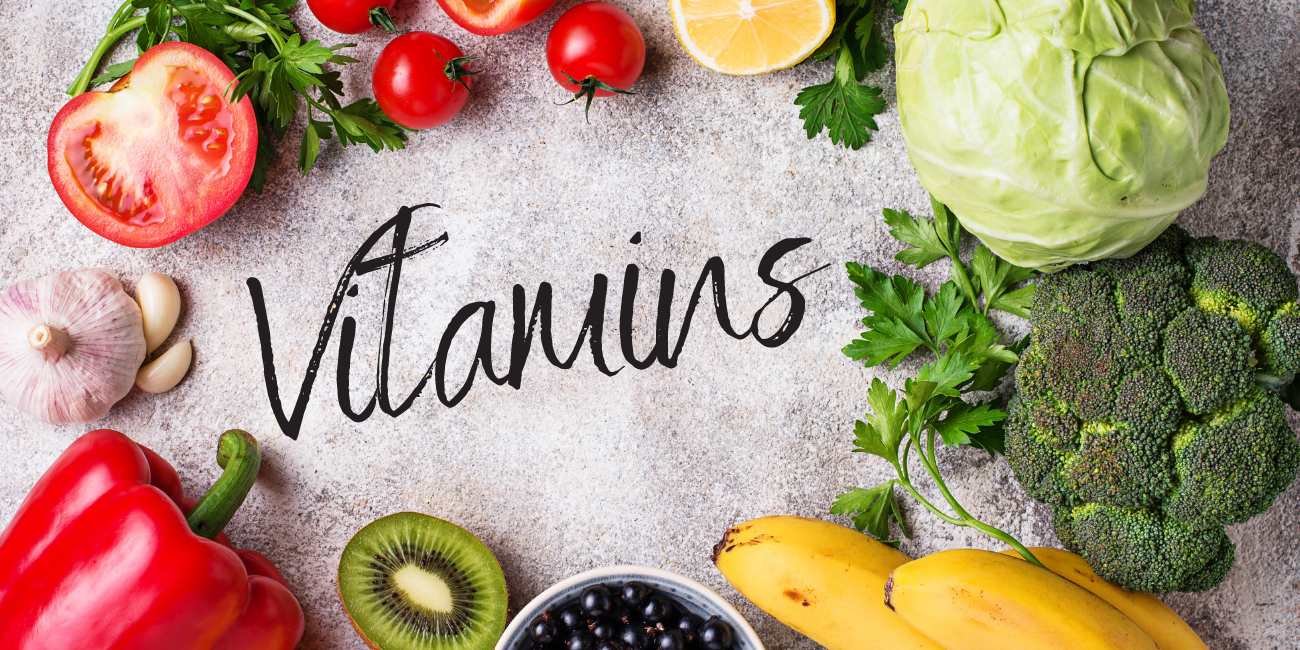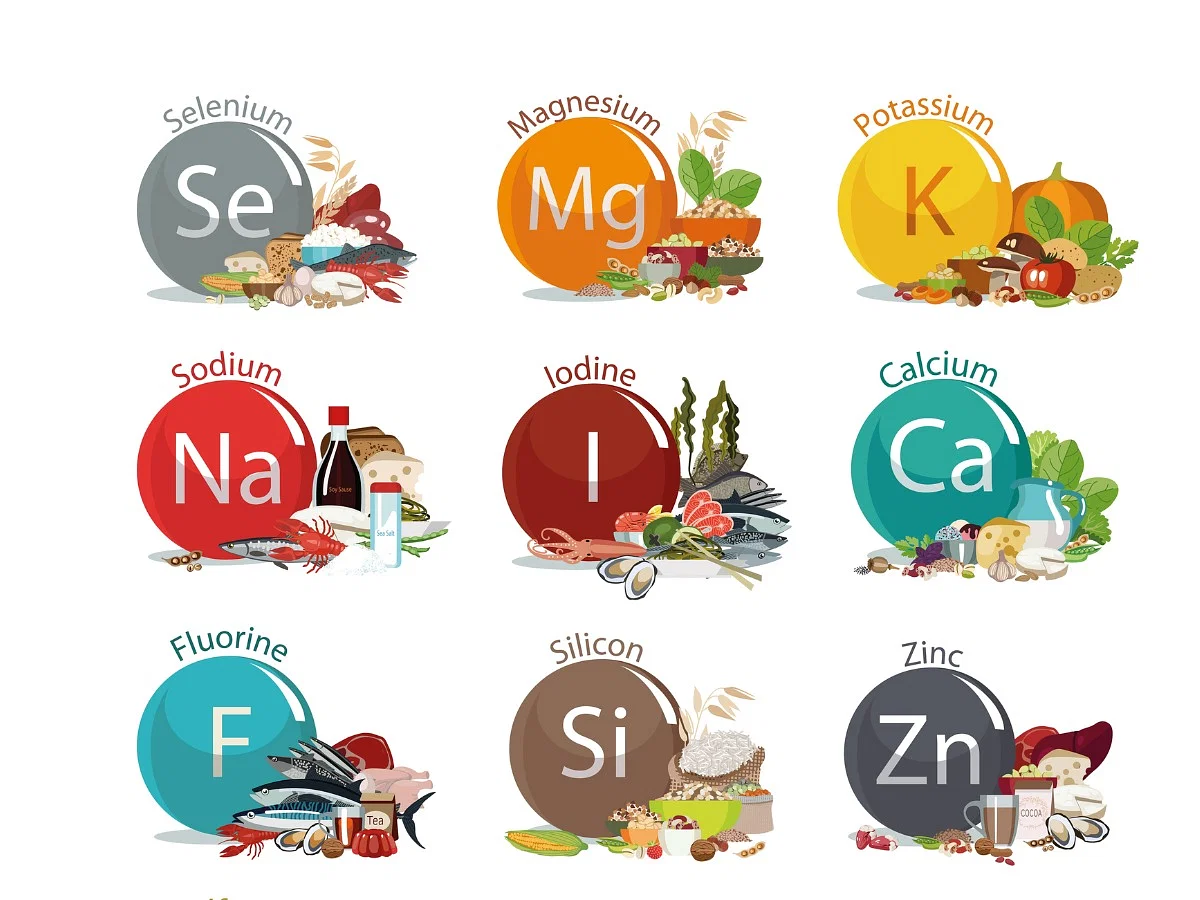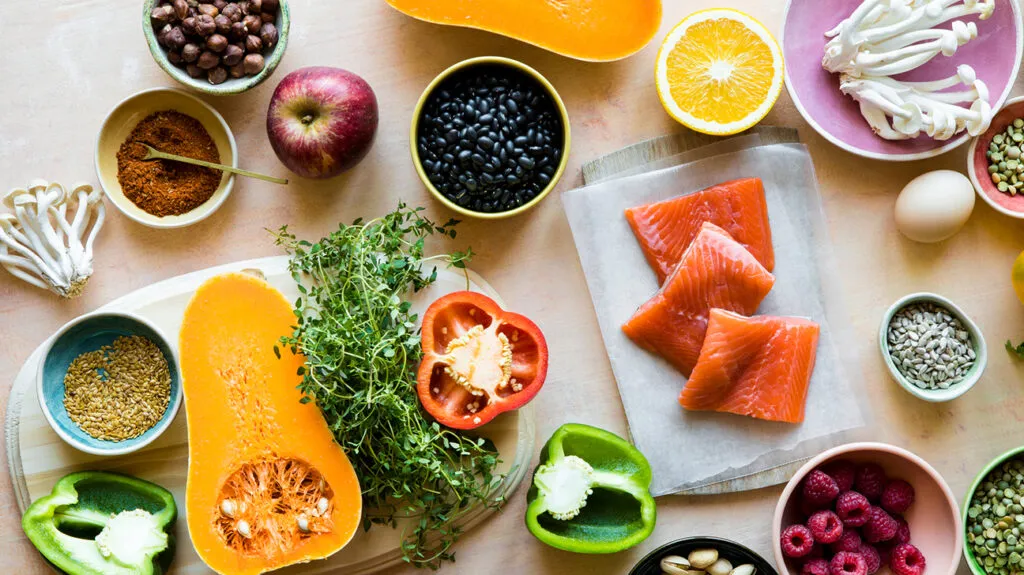If you want to have a deep understanding of vitamins & minerals, as well as how to properly incorporate them into your daily meals, then this is the article for you.
What are Vitamins?

Everything about the types of foods that contain vitamins and their roles will be summarized in this section.
1. Overview of Vitamins
Belong to the group of micronutrients, Vitamins are organic compounds that are present in small amounts in natural foods that are consumed daily. Since vitamins can dissolve in water or fat, they are divided into two types:
-
Fat-soluble vitamins: Vitamins A, D, E, and K (they exist for a long time in the body, stored in fat tissue and the liver)
-
Water-soluble vitamins: Vitamin C and all types of vitamin B (they do not exist for long in the body and are excreted through the urinary tract)
2. Foods containing vitamins
There are 13 types of vitamins: vitamin A, vitamin C, vitamin D, vitamin E, vitamin K, and vitamin B (B1, B2, B3, B5, B6, B7, B9, B12). Specifically:
|
VITAMIN
|
FUNCTION
|
FOOD SOURCES
|
Vitamin A
|
helps to form and maintain healthy teeth, bones, soft tissue, mucous membranes, and skin. It also promotes good eyesight and fights against aging
|
-
Fruits, dark green leafy vegetables
-
Liver, red meat, fish, and dairy products (cheese, yogurt, butter, cream…)
|
Vitamin C
|
helps the body absorb iron and maintain healthy tissues, teeth, and gums. It also slows down the oxidation process, which is widely used in dermatology and hemorrhagic disorders
|
-
Broccoli, brussels sprouts, kale, and other greens
-
Fruits (kiwi, strawberries, citrus fruits...)
|
Vitamin D
|
is produced by the body when exposed to sunlight, helps the body absorb calcium and phosphorus in the blood, and strengthens teeth & bones
|
-
Fish (salmon, tuna, sardines, mackerel), fish oil
-
Fortified cereals and dairy products…
|
Vitamin E
|
helps the body form red blood cells and use vitamin K. It also helps treat skin diseases and blood cells
|
-
Avocado, leafy greens (spinach, kale, collard greens…)
-
Vegetable oils (wheat germ, corn, sunflower…)
-
Nuts, seeds, and wheat germ...
|
Vitamin K
|
a deficiency in vitamin K can cause blood to clot poorly, leading to continuous bleeding from wounds
|
-
Leafy green vegetables (kale, spinach, collard greens), broccoli, brussels sprouts…)
-
Vegetable oils (soybean, canola, olive…)
-
Fish, liver, and meat…
|
Vitamin B1
(thiamine)
|
helps convert carbohydrates into energy and is also necessary for cardiovascular and nervous system activities
|
-
Fortified cereals, bread, and pasta
-
Pork, beef, liver, and nuts…
-
Legumes, nuts & grains…
|
Vitamin B2 (riboflavin)
|
works with other B vitamins, plays an important role in producing red blood cells and body development
|
-
Fish (mackerel, herring, salmon, tuna...)
-
Red meat, eggs, milk & dairy products
-
Fruits, vegetables, almonds, sesame seeds…
|
Vitamin B3
(niacin)
|
helps maintain healthy nerves and skin. It also lowers triglycerides at high doses
|
-
Avocados, nuts, legumes…
-
Bread & cereals, potatoes, eggs…
-
Sea fish, lean meat & poultry…
|
Vitamin B6 (pyridoxine)
|
helps form red blood cells and maintain brain function. It plays an important role in protein metabolism and chemical reactions in the body
|
|
Vitamin B12 (cyanocobalamin)
|
plays an important role in metabolism. It helps form red blood cells and maintains the central and peripheral nervous systems
|
Special: Animal sources of vitamin B12 are much better absorbed by the body than plant sources
|
Vitamin B5
(pantothenic acid)
|
necessary for food metabolism. It helps produce hormones and cholesterol in the body
|
-
Avocados, legumes/mushrooms/vegetables, whole grains…
-
Broccoli, kale, vegetables of the cabbage family
-
Eggs, milk, organ meats, poultry…
|
Vitamin B7
(biotin)
|
necessary for protein and carbohydrate metabolism. It is involved in hormones and cholesterol production
|
-
Chocolate, milk, cereal, egg yolk…
-
beans, yeast, nuts
-
Organ meat (liver, kidney), pork…
|
Vitamin B9
(folate hay folic acid)
|
works with vitamin B12 to regenerate red blood cells. It is necessary for DNA production, controlling tissue development, and cell function
|
-
Asparagus, broccoli, radish…
-
Cereals, legumes, peanut butter, wheat germ…
-
Green leafy vegetables (spinach, lettuce...)
|
What are Minerals?

Minerals also belong to the group of micronutrients, inorganic substances present in soil and water. There are hundreds of types of minerals on our planet. Minerals are a general noun. In fact, minerals must be understood in the following three types to avoid confusion:
-
nutrient minerals: found in food and drinking water. Plants, animals, and humans can absorb them
-
silicate mineral: found naturally in the form of quartz and rocks, account for 90% of the Earth's crust
-
mineral disambiguation: often in the form of crystals, formed due to geological processes. This includes nutrient minerals in general
In this section, we are talking about nutrient minerals
1. Overview of Minerals
Nutrient minerals are divided into 2 types:
-
Macrominerals: including calcium, potassium, phosphorus, sulfur, sodium, and magnesium (usually needed by the body in large enough amounts)
-
Microminerals: including iron, zinc, copper, chlorine, manganese, cobalt, molybdenum, iodine, and selenium (usually needed by the body in smaller amounts than macrominerals)
2. Foods containing minerals
|
MINERALS
|
FUNCTION
|
FOOD SOURCES
|
Zinc
|
Stimulates the activity of enzymes, supports the immune system, protects taste and smell, participates in DNA synthesis
|
-
Oysters, red meat, poultry
-
Various seeds, whole grains
-
Dairy products…
|
|
Sodium
|
Combines with chlorine to balance extracellular fluid, regulate blood pressure…
|
-
Table salt (sodium chloride, the main source)
-
Sea vegetables, spinach, milk…
|
Selenium
|
Plays an important role in the immune system, affects the development of white blood cells. Selenium deficiency inhibits the immune system, impairs white blood cell function, and disrupts the digestive system…
|
|
Potassium
|
Essential for the central nervous system. Involved in balancing fluids in the body. If potassium concentrations are disturbed, it can cause heart rhythm disturbances
|
-
Sweet potatoes, tomatoes, potatoes
-
Beans, bananas, dried apricots, carrots, oranges…
-
Dairy products, seafood…
|
Phosphorus
|
Helps develop bones and teeth. Involved in muscle contraction, blood clotting, kidney and nerve function. Regenerates tissues and cells and maintains normal heart rhythm
|
|
Molybdenum
|
Prevents anemia, helps detoxify the body of copper. Reduces malnutrition in children…
|
-
Various beans, nuts…
-
Whole grains…
|
Manganese
|
Regulates brain activity, produces energy. Helps the body absorb vitamins (C, E...)
|
|
Magnesium
|
Essential for digestive function, especially for muscle contractions and nerve impulses. It helps regulate blood sugar levels, blood pressure and maintains bone health
|
-
Spinach, various beans, nuts, seeds
-
Whole grains, peanut butter, avocado
|
Iron
|
Essential for the process of red blood cell production. Iron deficiency causes anemia, hair loss, headaches, and dizziness…
|
|
Iodine
|
Develops the nervous system, reproductive system, and body parts (heart, digestive system, skin - hair - nails...). Maintains energy and regulates body temperature…
|
|
Copper
|
Converts iron and fat. Antioxidant, prevents cancer…
|
-
Animal liver, seafood, oysters...
-
Whole grains, various beans, nuts, seeds...
|
Cobalt
|
Treats mineral deficiencies in the body. In addition, cobalt-60 is used in cancer treatment and sterilization of medical equipment…
|
|
Chromium
|
Regulates blood sugar levels in the body. Chromium deficiency increases the risk of fat accumulation and heart disease
|
-
Broccoli, grape juice...
-
Meat, whole grains...
|
Chlorine
|
Composition of stomach acid. Chlorine and Sodium help balance fluids in the body
|
|
Calcium
|
Forms the majority of bone and tooth structure. Helps children grow taller, increases immunity, and eliminates harmful bacteria…
|
-
Dairy products, eggs
-
Canned fish with bones (salmon, sardines...)
-
Nuts, seeds, leafy greens, tofu, parsley, oregano, thyme, cinnamon...
|
Comparison of macronutrients and micronutrients

Vitamins and minerals are two types of micronutrients. As the name suggests ("micro" meaning small), micronutrients are nutrients that people need in small amounts in their diet. Unlike macronutrients - which Soumaki mentioned in the previous post - micronutrients have the following characteristics:
|
CHARACTERISTICS
|
MACRONUTRIENTS
|
MICRONUTRIENTS
|
|
Body's needs
|
Body needs a large amount
|
Body needs a very small amount
|
|
Main function
|
Provide energy for the body
|
Prevent diseases and illnesses
|
|
Consequences of deficiency
|
Malnutrition with edema (Kwashiorkor) and atrophy (Marasmus)...
|
Anemia, goiter, rickets…
|
|
Consequences of overconsumption
|
Increased risk of heart disease, diabetes, obesity...
|
Liver and nerve damage
|
|
Classification
|
Carbohydrates (carbs), protein, fat & fiber
|
minerals and vitamins
|
Sources
|
Plentiful in cereals, fish, legumes, meat, nuts, potatoes...
|
Fruits, vegetables, eggs, fermented foods, leafy greens...
|
Benefits
|
Provide the necessary energy for the body's metabolic processes
|
Contribute to the development of the body and prevent diseases and illnesses
|
Tips on getting the right vitamins & minerals
Nowadays, people often buy functional foods to supplement vitamins & minerals for their bodies. This is not bad, but you should not abuse functional foods and drugs. Instead, build a balanced diet with enough nutrients from a variety of food sources. Thus, a sustainable lifestyle, physical and mental balance is established.
If you want to study more about the recommended nutritional needs of Vietnamese people, including macronutrients, vitamins, and minerals; please refer to this report.
Hopefully, Soumaki's sharing above helps you understand more about the types of vitamins & minerals in food, as well as how to properly supplement them for your body. Stay tuned for more useful nutritional information from Soumaki in the following posts.